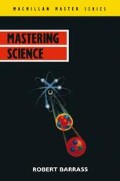Abstract
Light passes through transparent material (for example, glass) but not through opaque material (for example, wood). If an opaque object is placed in front of a point light source, in a darkened room, a sharp edged shadow is formed in the region of less intense light — indicating that light travels in straight lines (see Figure 17.1). You can imagine light spreading from the point source in all directions, as rays, in straight lines. However, in a diagram (such as Figure 17.1) only those rays needed to show the position of the shadow are represented.
Preview
Unable to display preview. Download preview PDF.
Copyright information
© 1991 Robert Barrass
About this chapter
Cite this chapter
Barrass, R. (1991). Light and seeing. In: Mastering Science. Macmillan Master Series. Palgrave, London. https://doi.org/10.1007/978-1-349-11075-9_17
Download citation
DOI: https://doi.org/10.1007/978-1-349-11075-9_17
Publisher Name: Palgrave, London
Print ISBN: 978-0-333-49985-6
Online ISBN: 978-1-349-11075-9
eBook Packages: Palgrave Social & Cultural Studies CollectionSocial Sciences (R0)

